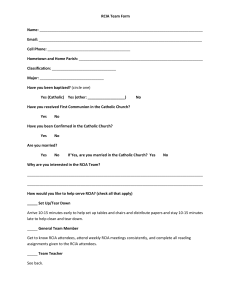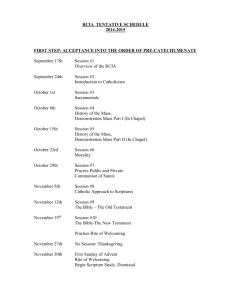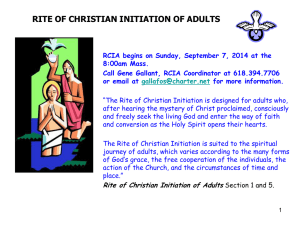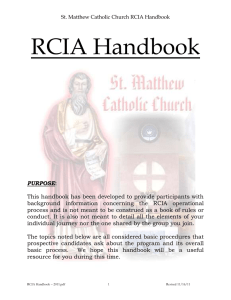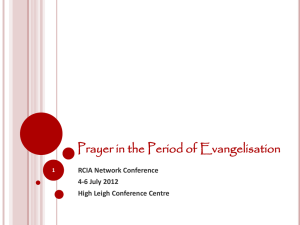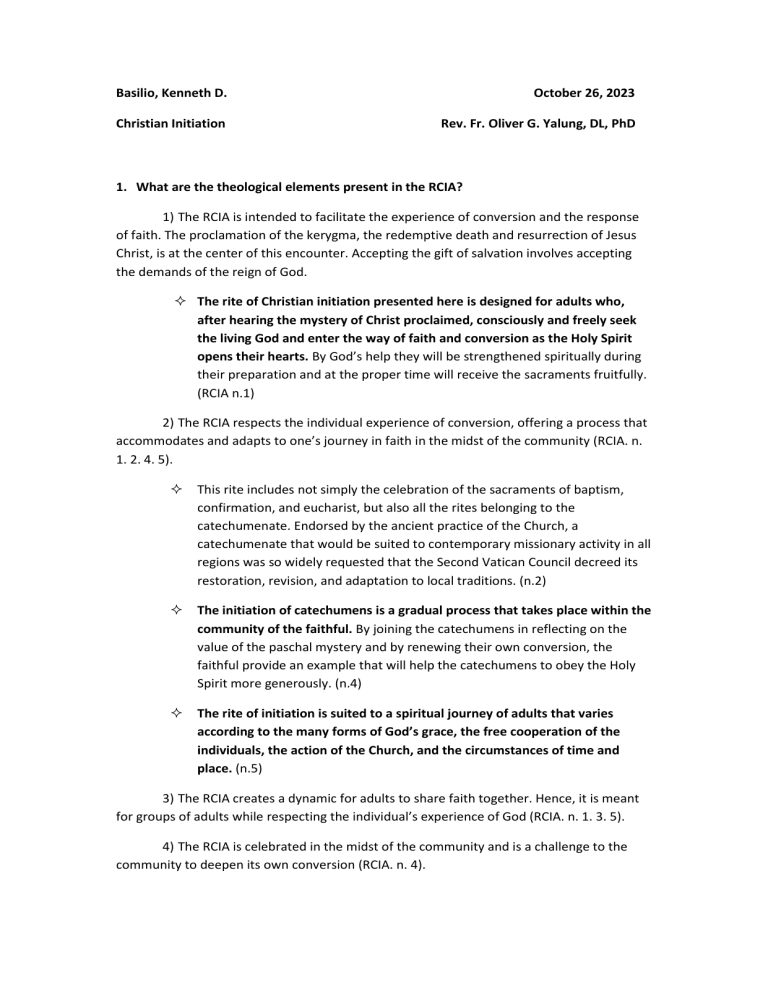
Basilio, Kenneth D. October 26, 2023 Christian Initiation Rev. Fr. Oliver G. Yalung, DL, PhD 1. What are the theological elements present in the RCIA? 1) The RCIA is intended to facilitate the experience of conversion and the response of faith. The proclamation of the kerygma, the redemptive death and resurrection of Jesus Christ, is at the center of this encounter. Accepting the gift of salvation involves accepting the demands of the reign of God. The rite of Christian initiation presented here is designed for adults who, after hearing the mystery of Christ proclaimed, consciously and freely seek the living God and enter the way of faith and conversion as the Holy Spirit opens their hearts. By God’s help they will be strengthened spiritually during their preparation and at the proper time will receive the sacraments fruitfully. (RCIA n.1) 2) The RCIA respects the individual experience of conversion, offering a process that accommodates and adapts to one’s journey in faith in the midst of the community (RCIA. n. 1. 2. 4. 5). This rite includes not simply the celebration of the sacraments of baptism, confirmation, and eucharist, but also all the rites belonging to the catechumenate. Endorsed by the ancient practice of the Church, a catechumenate that would be suited to contemporary missionary activity in all regions was so widely requested that the Second Vatican Council decreed its restoration, revision, and adaptation to local traditions. (n.2) The initiation of catechumens is a gradual process that takes place within the community of the faithful. By joining the catechumens in reflecting on the value of the paschal mystery and by renewing their own conversion, the faithful provide an example that will help the catechumens to obey the Holy Spirit more generously. (n.4) The rite of initiation is suited to a spiritual journey of adults that varies according to the many forms of God’s grace, the free cooperation of the individuals, the action of the Church, and the circumstances of time and place. (n.5) 3) The RCIA creates a dynamic for adults to share faith together. Hence, it is meant for groups of adults while respecting the individual’s experience of God (RCIA. n. 1. 3. 5). 4) The RCIA is celebrated in the midst of the community and is a challenge to the community to deepen its own conversion (RCIA. n. 4). The initiation of catechumens is a gradual process that takes place within the community of the faithful. By joining the catechumens in reflecting on the value of the paschal mystery and by renewing their own conversion, the faithful provide an example that will help the catechumens to obey the Holy Spirit more generously. (n.4) 5) The proper time to celebrate the rituals of the RCIA will be influenced by both the individual’s conversion and the liturgical calendar (RCIA. n. 18-30). 6) The RCIA recognizes that growth in faith that leads one to commitment happens gradually and in discernible periods (RCIA. n. 7). The steps lead to periods of inquiry and growth; alternatively the periods may also be seen as preparing for the ensuing step. 1. The first period consists of inquiry on the part of the candidates and of evangelization and the precatechumenate on the part of the Church. It ends with the rite of acceptance into the order of catechumens. 2. The second period, which begins with the rite of acceptance into the order of catechumens and may last for several years, includes catechesis and the rites connected with catechesis. It comes to an end on the day of election. 3. The third and much shorter period, which follows the rite of election, ordinarily coincides with the Lenten preparation for the Easter celebration and the sacraments of initiation. It is a time of purification and enlightenment and includes the celebration of the rites belonging to this period. 4. The final period extends through the whole Easter season and is devoted to the postbaptismal catechesis or mystagogy. It is a time for deepening the Christian experience, for spiritual growth, and for entering more fully into the life and unity of the community. Thus there are four continuous periods: the precatechumenate, the period for hearing the first preaching of the Gospel (nos. 36-40); the period of the catechumenate, set aside for a thorough catechesis and for the rites belonging to this period (nos. 75-104); the period of purification and enlightenment (Lenten preparation), designed for a more intense spiritual preparation, which is assisted by the celebration of the scrutinies and presentations (nos. 125-197); and the period of postbaptismal catechesis or mystagogy, marked by the new experience of sacraments and community (nos. 234-241). (n.7) 7) The RCIA bears a markedly paschal character. The proper time for celebrating the sacraments of initiation is the Easter Vigil (RCIA. n. 8. 23). The whole initiation must bear a markedly paschal character, since the initiation of Christians is the first sacramental sharing in Christ’s dying and, rising and since, in addition, the period of purification and enlightenment ordinarily coincides with Lent and the period of post-baptismal catechesis or mystagogy with the Easter season. (n.8) The celebration of the sacraments of Christian initiation (nos. 198-233) should take place at the Easter Vigil itself (see nos. 8, 17). But if there are a great many catechumens, the sacraments are given to the majority that night and reception of the sacraments by the rest may be transferred to days within the Easter octave, whether at the principal church or at a mission station. In this case either the Mass of the day or one of the ritual Masses ‘Christian Initiation: Baptism’ may be used and the readings are chosen from those of the Easter Vigil. (n.23) 8) The RCIA affirms the responsibility for ministry and service of all the baptized. Furthermore, both explicitly and implicitly, the rite calls for a variety of ministries for full implementation (RCIA. n. 9-16). 9) The RCIA recognizes the importance of incorporating the particular needs and demands of the community and the candidate. The ritual celebrations need to authentically express the conversion experience of the candidates. Therefore, the rite encourages the appropriate adaptation of the RCIA at all levels (RCIA. n. 32-35) 2. What are the catechetical elements can be seen? Catechetical Elements in RCIA: 1. The RCIA proposes the establishment of a new catechumenate for children, which becomes the object of pastoral care. This highlights the catechetical element of nurturing and guiding children in their faith journey (RCIA. n. 242-284). 2. The RCIA suggests an itinerary through catechetical tools to make the sacraments of Christian initiation accessible to young children. This emphasizes the importance of catechetical methods in facilitating the understanding and reception of these sacraments. 3. The RCIA recognizes that Christian initiation is not merely a catechetical or pedagogic procedure but an event in which God is the principal actor. This underscores the belief that the work of salvation is carried out through the sacramental rites. 4. The RCIA proposes a structure for Christian initiation that includes four periods and three steps. This highlights the catechetical element of a gradual and progressive journey towards full integration in the Church (RCIA. n. 41-241). 5. The RCIA introduces rituals and formulas specifically for catechumens, such as the renouncement to Satan and the anointing with the oil of the catechumens. These elements contribute to the catechetical preparation and initiation of individuals into the Christian faith (RCIA. n. 203-204). 6. The RCIA includes the delivery of the Symbol (Creed) and the prayer of the Lord (Our Father) as important moments in the catechetical process. These moments allow for the deepening of faith and the development of a filial relationship with God. Overall, the RCIA incorporates various catechetical elements, such as the establishment of a new catechumenate, the use of catechetical tools, the recognition of Christian initiation as an event, the inclusion of stages and passages, the introduction of rituals and formulas for catechumens, and the delivery of catechetical content. 3. What elements were drawn from ancient sources? Elements drawn from ancient sources in RCIA: 1. The RCIA introduced three formulas of renouncement, drawing from ancient sources. One of the formulas is the same as the Ordo Confirmationis, while the other two are the same as the Ordo Baptismi parvulorum. 2. The RCIA includes the "Unctio Olei Cathecumenorum," which is the unction with the oil of the catechumens, an ancient practice in Christian initiation. Explanatory Rites: The baptismal washing is followed by rites that give expression to the effects of the sacrament just received. The anointing with chrism is a sign of the royal priesthood of the baptised and that they are now numbered in the company of the people of God. The clothing with the baptismal garment signifies the new dignity they have received. The presentation of a lighted candle shows that they are called to walk as befits the children of the light. (n.207) 3. RCIA contains a few of the ancient prayers of the Gelasian. For example, the Preces nostras (n. 87), which corresponds to the GeV 286, contains a traditional allusion to the Deus patrum nostrorum of the GeV 290 (see RCIA n. 95). 4. The RCIA also includes the ancient discipline of the scrutinies, which was restored in the preparatory work on the edition of the Roman Ritual. By ancient usage, the presentations, since they take place after the scrutinies, are part of the same period of purification and enlightenment. They are celebrated during the week. The presentation of the Creed to the catechumens (nos. 144-150) takes place during the week after the first scrutiny; the presentation of the Lord’s Prayer (nos. 165-171) during the week after the third scrutiny. For pastoral reasons, however, to enrich the liturgy in the period of the catechumenate, each presentation may be transferred and celebrated during the period of the catechumenate as a kind of ‘rite of passage’ (see nos. 79, 103-104). (RCIA n. 21) These elements were incorporated into the RCIA to maintain and honor the ancient traditions of Christian initiation. 4.What liturgical adaptations can be perceived? The liturgical adaptations perceived in RCIA are: 1. Adaptation of Rites for Local Traditions: The Council decreed that all the rites of the catechumenate should be reestablished, revised, and suited for the local traditions, indicating a need for adaptation in the liturgical practices. 2. Adaptation of Confirmation Rite: The council fathers requested a revision of the confirmation rite to highlight its intimate connection with the whole Christian initiation, suggesting an adaptation in the liturgical practices related to confirmation. 3. Adaptations of the Conferences of Bishops in the Use of the Roman Ritual: The rite of Christian initiation of adults allows for other adaptations that will be decided by the conference of bishops. Each conference of bishops has discretionary power to make the following decisions: o to insert into the rite of acceptance into the order of catechumens a first exorcism and a renunciation of false worship, in regions where paganism is widespread (see nos. 6972) o to decide that in the same rite the tracing of the sign of the cross upon the forehead (nos. 54-55) be replaced by making that sign in front of the forehead, in regions where the act of touching may not seem proper o to allow within the same rite, according to local customs, additional rites that symbolize reception into the community (no. 74); o to establish during the period of the catechumenate, in addition to the usual rites (nos. 81-97), ‘rites of passage’: for example, early celebration of the presentations (nos. 144-150, 165-171), the ephphetha rite (nos. 184-186), the catechumens’ recitation of the Creed (nos. 180-183), or even an anointing of the catechumens (nos. 98-102); o to decide on the omission of the anointing with the oil of catechumens (no. 218) or its transferral to the preparation rites for Holy Saturday (nos. 190-194) or its use during the period of the catechumen ate as a kind of ‘rite of passage’ (nos. 98-100) o to make more specific and detailed the formularies of renunciation for the rite of acceptance into the order of catechumens (nos. 70-72) and for the celebration of baptism (no. 217). (RCIA. n. 33) 4. Adaptations by the Bishop: It pertains to the bishop for his own diocese. The following are: o to decide whether and when, as circumstances warrant, the entire rite of Christian initiation may be celebrated outside the usual times (see no. 26) o to permit the simple rite to be used in whole or in part (see no. 307) o to preside at the rite of election and to ratify, personally or through a delegate, the admission of the elect (see no. 12) (RCIA n. 34) 5. Adaptations by the Minister: The minister through his prudent pastoral judgement can make necessary adaptations. Celebrants should make full and intelligent use of the freedom given to them either in Christian Initiation, General Introduction (no. 34) or in the rubrics of the rite itself. In many places the manner of acting or praying is intentionally left undetermined or two alternatives are offered, so that ministers, according to their prudent pastoral judgment, may accommodate the rite to die circumstances of the candidates and others who are present. In all the rites the greatest freedom is left in the invitations and instructions, and the intercessions may always be shortened, changed, or even expanded with new intentions, in order to fit the circumstances or special situation of the candidates (for example, a sad or joyful event occurring in a family) or of the others present (for example, sorrow or joy common to the parish or civic community).The minister will also adapt the texts by changing the gender and number as required. (RCIA n. 35) These are the liturgical adaptations that can be perceived based on the given document data. 5.What pastoral adaptations can be traced? The pastoral adaptations that can be traced in RCIA are: 1. 2. 3. 4. Adaptation of the Baptism Language: RCIA mentions that the baptism of adults could be celebrated in the language of the people, allowing for a certain adaptation in the liturgy. Adaptation of Rite for Children: The document mentions a rite suited for little children that is based on the rite of adults but includes new elements, indicating an adaptation to cater to the needs and characteristics of children. (RCIA. nos. 242-249) Time and Place of Initiation: As a general rule, the sacraments of initiation are celebrated at the Easter Vigil, and the rite of election takes place on the First Sunday of Lent. The rest of the rites are spaced based on the structure and arrangement of the catechumenate. However, for serious pastoral needs, the schedule can be arranged differently. (RCIA. nos. 24-31) Adaptations by the Conferences of Bishops: Each conference of bishops has discretionary power to make the following decisions: o 5. to establish for the precatechumenate, where it seems advisable, some way of receiving inquirers who are interested in the catechumenate (see no. 39) o to decide that in the same rite candidates receive a new name in regions where it is the practice of non-Christian religions to give a new name to initiates immediately (no. 73) (RCIA. n. 33) Adaptations by the Bishop: The following are: o to set up the formation programme of the catechumenate and to lay down norms according to local needs (see no. 12) o to dispense, on the basis of some serious obstacle, from one scrutiny or, in extraordinary circumstances, even from two (see no. 307) o to depute catechists, truly worthy and properly prepared, to give the exorcisms and blessings (see nos. 12, 16) o in keeping with the provisions of law,14 to stipulate the requisite age for sponsors (see Christian Initiation, General Introduction, no. 10,2). (RCIA n. 34)
